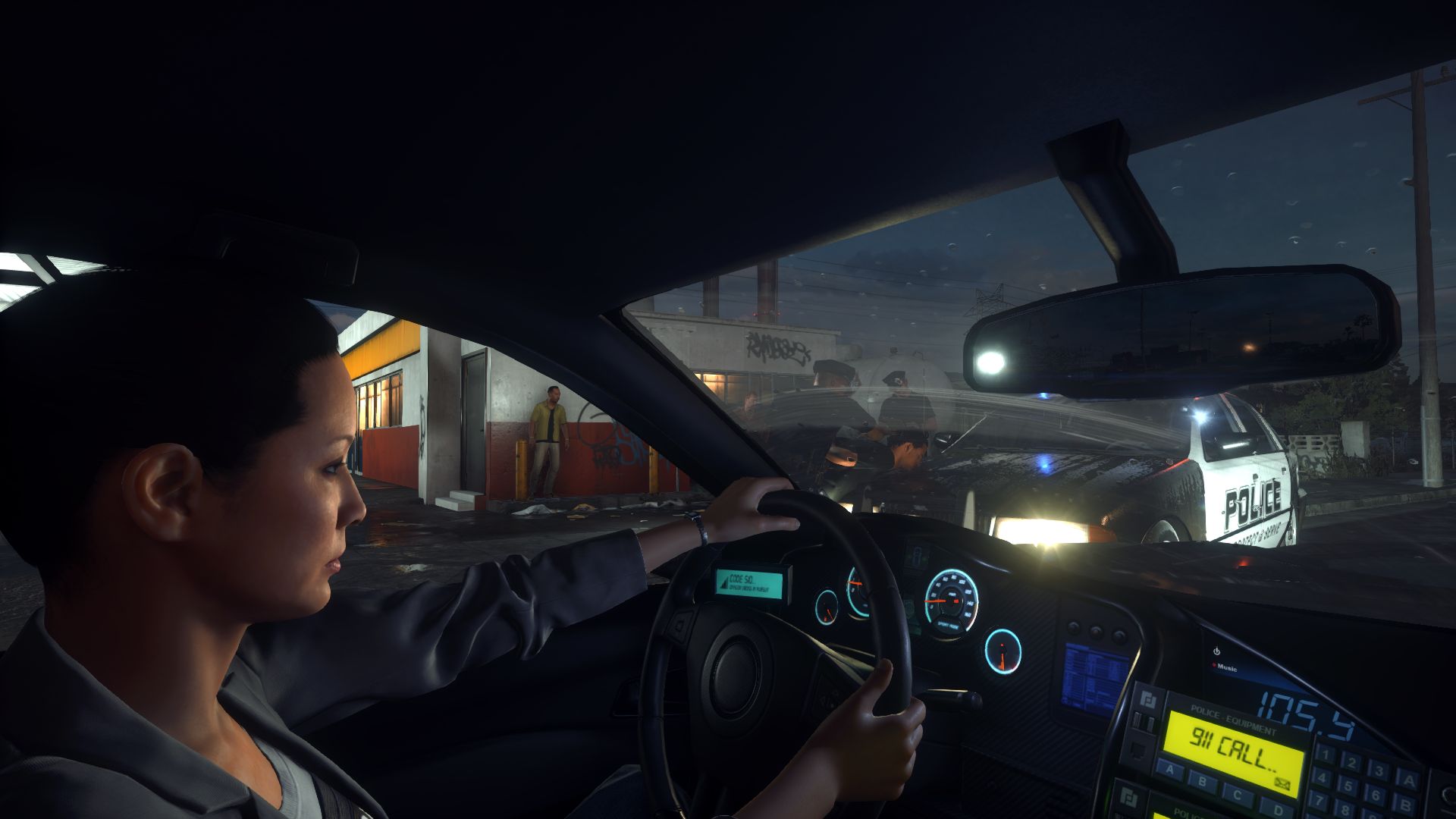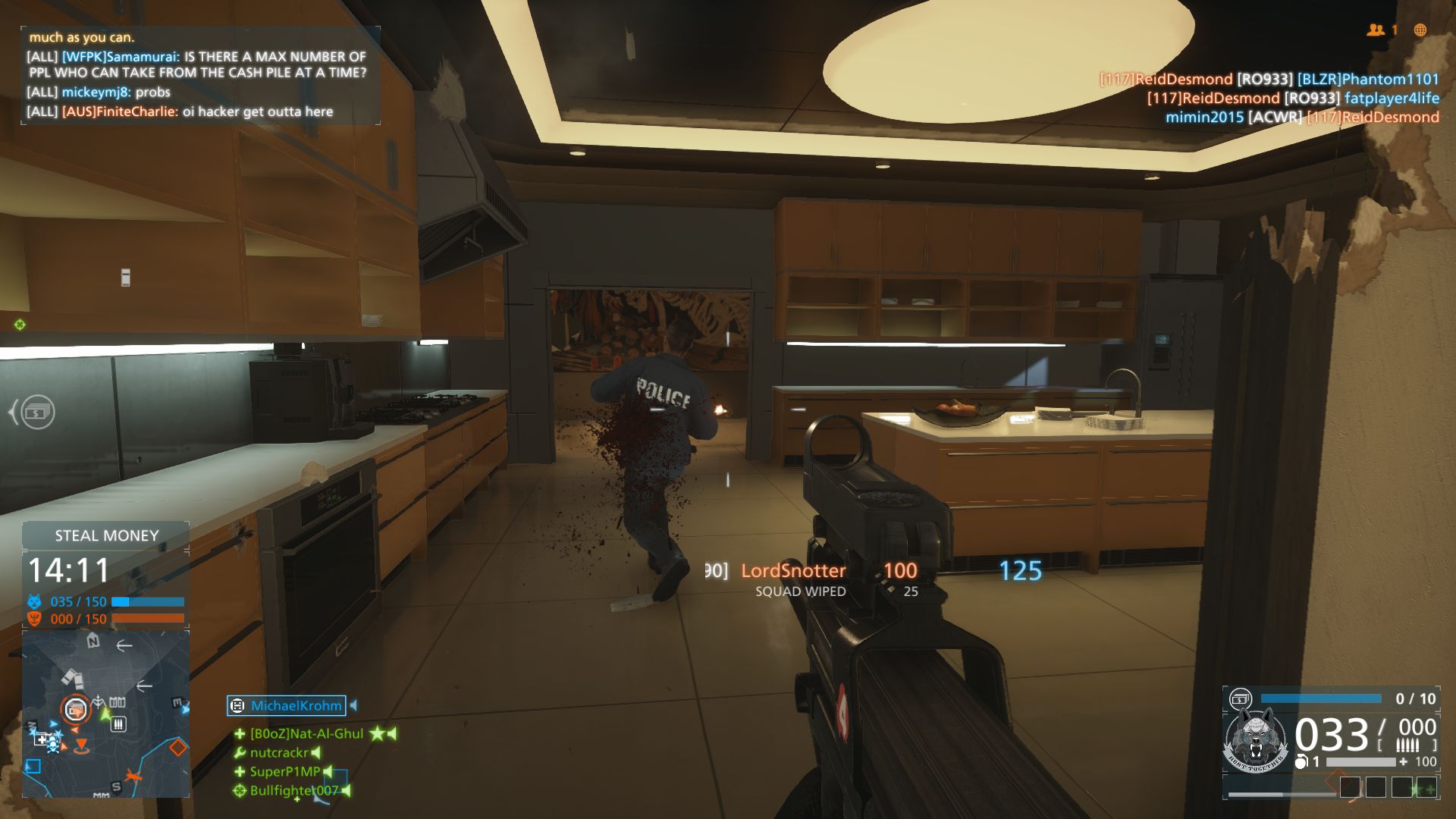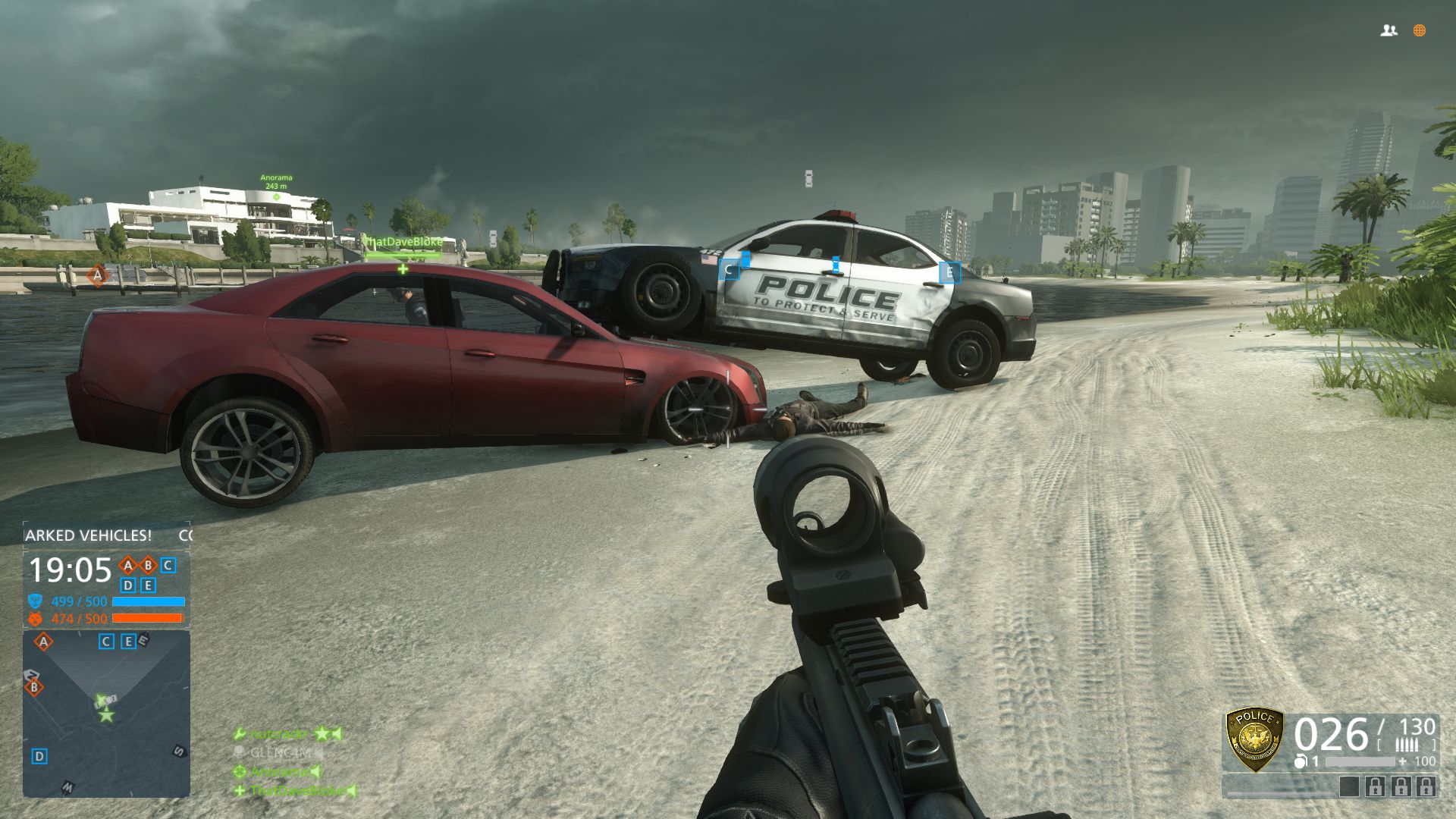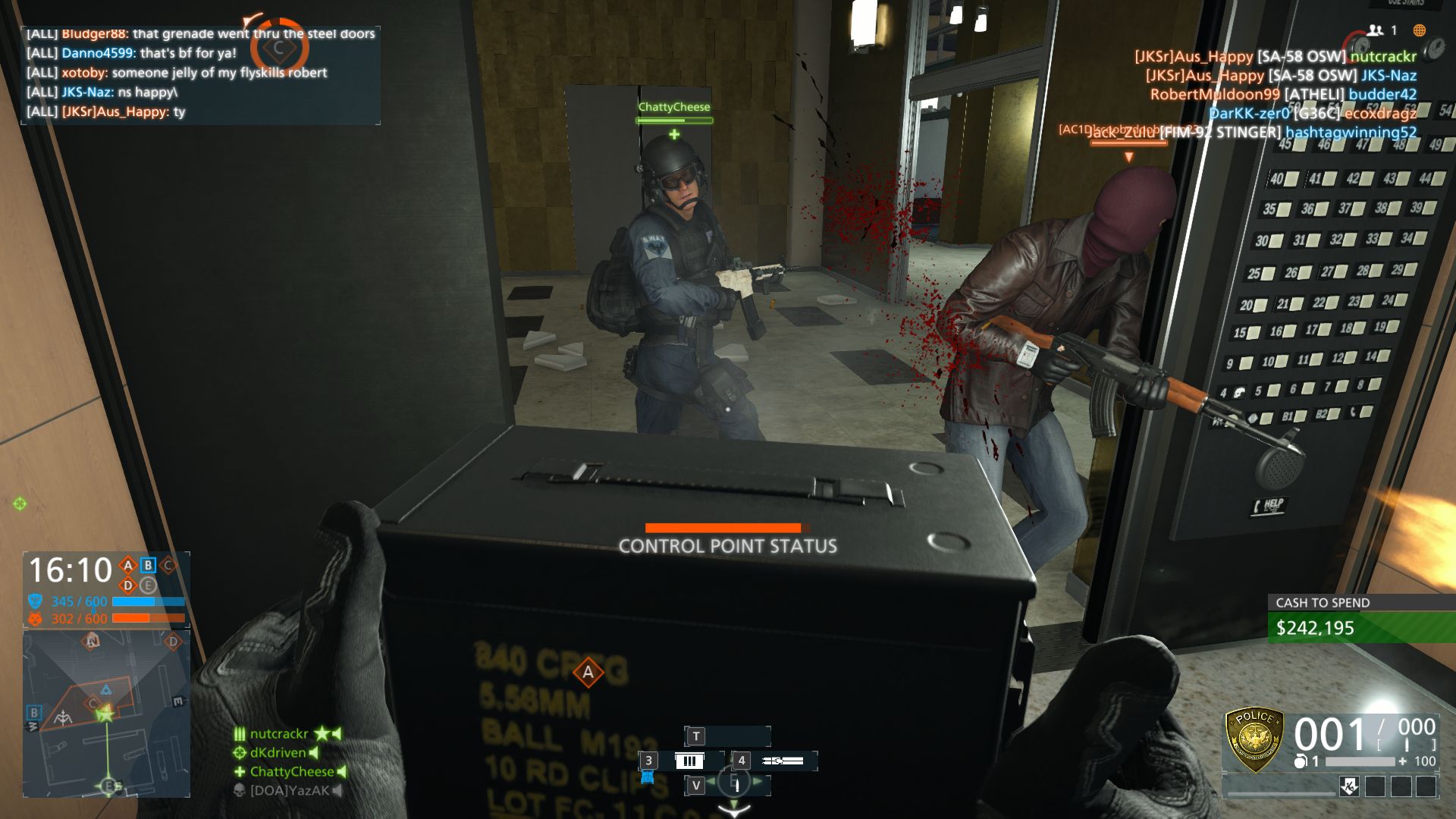Battlefield Hardline Review
Battlefield Hardline is a clever sidestep for a multiplayer franchise that has, until now, focused on war. Instead of a global conflict, it features skirmishes between criminals and law enforcement; for the first time ever, there are no tanks in multiplayer. Consequently, much of the combat revolves around infantry and light vehicles. Player classes have been tweaked slightly, in an effort to differ from its predecessors, but the core tenets of the franchise have been retained. Although primarily a multiplayer experience, there is a single player component. Developers at Visceral Games are best known for their single player titles, and they have tried to exploit the police theme in an episodic campaign that emphasizes stealth and non-lethal takedowns.

The police theme is strong during the campaign, but no donuts are consumed
Told across ten interconnected episodes, the Hardline campaign revolves around cocaine trafficking and police corruption. Players take the role of detective Nick Mendoza from the Miami Police Department and are initially tasked with finding the source of a new drug supplier. During your investigation, you become aware that one of your colleagues may be involved. Things are not as they seem though, as you clash with both sides of the law and the lines blur.
The staging, presentation and pacing aspects are much clearer here than in previous Battlefield campaigns. Part of this is because each episode has a strong introduction and a fitting conclusion; unfortunately none of the cut scenes can be skipped, even on replay. There is good distinction between each episode as you explore attractive locations such as mangroves, deserts and an abandoned school. The characters are more believable too, although some are only involved for a few lines of dialogue. Your partner Khai, acted by Kelly Hu, has a starring role with smart dialogue. Fortunately you are never drowned in exposition and the main narrative moves along briskly.
Careful pacing of action is a crucial aspect of the campaign. The prevalence of stealth ensures you spend more time in detailed environments. Hidden evidence, scattered around the levels, builds case files that piece the story together. There are many segments without action, allowing the game to build context for an upcoming sequence. For example, an early chapter has you exploring the everglades with an Airboat and it can be 15 minutes before you meet resistance. A later episode has Mendoza returning to a crime scene alone, just as hurricane makes landfall outside. The careful easing in and out of conflict, along with the support from the environments, produces some memorable levels.
Although stealth is not required during conflicts, it is encouraged by limiting ammunition and rewarding you with weapons or online battlepacks. Many of the stealth areas are similar in design. First you get an overview of the area, such as a warehouse, and then you infiltrate with a choice of weapons and gadgets. Guards will patrol areas and you must avoid their vision cones to remain undetected. You can approach enemies with your badge and begin an arrest, but this somehow works when enemies are within earshot. If you are spotted without a badge, alarms bring reinforcements, so remaining unseen reduces danger.

You will get an overview of some areas to tag enemies and memorize the layout
Unfortunately the stealth is basic and not all that satisfying after a few episodes. The guard placement is trivial and can be exploited. An endless supply of shell casings is used to distract a single guard, but the distraction range is pitiful and other guards do not care if their friends return. The main stealth caveat is that you cannot move bodies, so you must takedown enemies in the right places. Non-lethal takedowns are the only way you get points, so avoiding all guards is no better than creating a massacre. Once spotted, enemies are able to track you through walls.
While it makes sense to discourage a detective from killing criminals, it can make you feel guilty for using the great weapons at your disposal. Even when pushed into unavoidable combat, you regret killing bad guys because you get no points for defending yourself. You can cheat the system by switching to the non-lethal tazer, but shocking enemies with hit and run tactics does not seem like an intended strategy. When you reach the maximum character level in the campaign, you can discard stealth and just shoot everything. Unfortunately the game rarely throws more than a handful of guards at you, preventing it from hitting a high gear. So while the stealth works, the implementation affects the shooting and needed more depth.
The story is unfortunately packed with many irrational plot conveniences. One example occurs when you crash near a derelict gas station and discover the abandoned garage contains two pristine vehicles that will take you to the next area. During a car chase in the aqueducts, you are given infinite ammo to take down pursuers. Another chase is at the helm of a truck that makes enemy cars explode on contact, as though they were on their way to a Michael Bay film set. The worst narrative convenience is reserved for a primary antagonist that infiltrates your base with just two companions, not long after a mission where he was surrounded by dozens of associates. These absurd story elements are especially bad when most of the campaign strives to be grounded. Overall however, the decent Hardline campaign proves that Visceral are still skilled at leading players through a solo adventure.
Online is suitably more chaotic than any part of the campaign, with subtle changes to the standard Battlefield formula. Infantry is the primary focus, with interference from deadly helicopters and fortified trucks. Death comes quickly from all sources, as damage models reward first to acquire targets. The cops and robbers theme is gingerly applied to the Battlefield mechanics, with the best application coming via hilarious callouts from characters. One criminal asked if this was ‘Police Academy’ due to the general ineptitude of the opposing team. The Commander role has been replaced by a ‘Hacker’ and he can interact with toxic gas and cameras. The experience never takes itself too seriously and carefully mixes the police theme into the franchise.

Shooting a cop in the back is just how you roleplay in Hardline
The four standard Battlefield classes return, with a different weapon system. Rocket launchers are now pickups, either around the map or from vehicles, giving all classes the power to destroy armoured units. All of the primary weapons and pistols are isolated to specific classes, creating more distinct roles at the cost of some player choice. Class weapons are a mix of familiar and new, with some initially locked to a specific faction to force variety. The gun attachment system is more natural, as you can now purchase your preferred sight after only a handful of kills. Melee weapons have been given some attention, with blunt tools that perform non-lethal takedowns from behind. Although your victim effectively dies from a non-lethal takedown, they can be ‘interrogated’ to reveal the location of other enemies. Weapons, attachments and gadgets are purchased with funds you earn from playing the game, making it the best unlock system in the series to date.
Several gadgets are shared across classes, including the grapple and zip-line. Both of these gadgets increase mobility and open new navigational paths. They are placed liberally across maps as pickups, so you do not need to sacrifice class gadgets. The grapple provides freeform rooftop access that would otherwise need a helicopter, so roof campers can be eliminated without needing to ascend booby-trapped ladders. The zip-line gadget is a great tool for making fast transitions between hotspots, but you need to be elevated from the target and the line is destroyed easily. These gadgets are best used in association with a specific map or game mode – the grapple is great when infiltrating a warehouse to rescue hostages and the zip-line helps avoid street combat in a bank heist. Selecting these gadgets can be wise for such scenarios, but they function great as battle pickups.
All nine multiplayer maps are used across many modes and this produces large and small combat arenas of varying quality. Large maps flow quite well in the 64-player Conquest mode, which was a main concern given the infantry focus. Downtown is one example and it incorporates numerous vertical layers and flanking routes. All large maps make use of light vehicles to bring players back into the action. On the small scale, maps like Growhouse are better for deathmatch, despite problematic spawning. Another small map, called The Block, compresses action into a narrow corridor and is cluttered with more than 16 players. Most of the maps are cleanly presented with subtle design elements that you come to appreciate over time. Destruction within maps is restrained too, aside from large events such as a train bridge collapsing. Routes can be opened with explosives at specific map locations, and some walls do crumble. Subdued destruction is carefully placed to retain map structure and create long-term surprises. The maps are varied, catering to the different modes, and they facilitate many healthy skirmishes.

Maps still have destruction, but it is used carefully
The multiplayer arenas look as good as they function, with Visceral making the most of the Frostbite engine. One pleasing side-effect of the reduced destruction is a greater distinction between maps; prefabricated buildings are rarely duplicated, meaning there is more unique content for each level. Texture quality is above standard, with interesting graffiti and advertising placards. Reflective surfaces give areas a clean appearance which contrasts nicely with the turbulent battles. Enclosed areas have the most detail, as they now look liveable and not just slabs of concrete or empty rooms. Despite the extra detail, targets are always clear because of sharp profiles and good lighting. It all makes for a great looking online experience that is packed with hidden detail.
Although the theme is cops and robbers, the game fares better when that aspect is underplayed. Modes that ignore the motives for each side, giving them both the same objective, seem to work the best. Hotwire requires both teams to steal vehicles and drive them at speed, making it Conquest with drivable capture points. Avoiding enemies is a primary task, but you do your team no favours by driving in circles while the enemy controls more vehicles. So there is incentive to push into action and regain ascendency, or at least guide pursuers into a trap. Teamwork forms naturally as players spawn in their own team’s cars and all passengers earn points. Driving a posse through streets and killing enemies on the roadside is satisfying. There is a strong desire to always be in locomotion, but you will sometimes find yourself stranded in the middle of the map. When that happens, there is an uneasy serenity as you wait for vehicles to circle back around.
Unfortunately the car physics in Hotwire leave a lot to be desired. Vehicles can stop dead if they hit an object that is only ankle high. Momentum is rarely preserved correctly when making jumps. Collisions between vehicles are problematic, causing a tanker truck to slide and fly into the air as though it was made of paper. There is insufficient feedback when vehicles take damage, requiring regular checks on car health as you try to watch the road. Poor car physics have been in the franchise for a few years now, but they have never been integral to a game mode before. Despite this, the continuous motion aspects of Hotwire make it strangely calming and a good addition to the franchise.

Cars get stuck on each other, sadly they do not form a super megazord unit
The Blood Money mode is not quite as relaxing, as it has teams fighting over a money pile in the centre of the map. You must bring money back to your vault and greed makes this more interesting. Completely filling your loot bag takes longer but you are better rewarded. Enemies are never far away from interrupting your withdrawal, so covering your team is essential. Running back to base with a full bag can be exhilarating. Both teams can also raid the vault of the opposing side, assuming they have any money. So you could skirt around the side of the map and ‘borrow’ from the opposing team, bypassing the frenzied struggle over the central money-pile. You can bet the enemy will react in kind to get their money back, spreading the action over the map as the round progresses. This tug of war over money is highly replayable with intuitive balance between defence and attack, and it could be the best new mode that the game introduces.
When the game implements asymmetric modes that have the cops and robbers playing their logical roles, it stumbles. Rescue is one such mode and it operates like Counter-Strike with criminals guarding hostages. Maps are often just tiny slices of large arenas with a suitable building to hold two hostages. Encounters can occur within seconds and rounds might not last a minute. Police only need to rescue one hostage, and carrying them has no movement or aiming penalty. Hostages are impervious to grenades and bullets, so there is no need to act carefully around them. Although a round-based mode, maps do not fully reset until four of nine rounds are complete. Any open doors or broken windows remain in their previous states for most of the match. Unlike Counter-Strike, the Rescue mode lacks finesse, uncompromising balance and perfected level design. The other modes that put teams in their logical roles fare slightly better, but Hardline is still best experienced when both teams are given the same objective.
Visceral delayed Hardline with the goal of reducing the technical problems that crippled its predecessor. Despite their efforts, some technical issues remain. Animation bugs occasionally show frozen or sliding characters. Rubber-banding lag returns and was so bad during one game that a recently-disarmed trip mine blew me to pieces. The kill cam is still not smooth, frequently getting stuck behind walls or shaking. Fortunately the number and severity of technical problems is a fraction of those found in Battlefield 4 at launch. It also performs better due to the infantry focus, maintaining smooth framerate on ultra settings across all maps and modes. Hardline has some bugs and balance issues, but they are unlikely to cause outrage.

The elevator music is worth dying for, irrespective of your lawful affiliation
Battlefield: Hardline is a worthy spinoff for the long running shooter franchise. Visceral Games have built a decent campaign that has careful pacing and detailed presentation. The online component introduces some great modes and uses the cops & robbers theme intelligently, without compromising the winning formula. New gadgets and some altered weapon loadouts change the familiar multiplayer classes. The maps are well designed and get better with time, despite inconspicuous destruction and the occasional bad map/mode combination. Series veterans will need to adjust to the frenzied infantry action, swapping their tanks for police cruisers, but with time they may come to appreciate the changes. Hardline stands out from its predecessors and is occasionally so much fun that it should be a crime.
